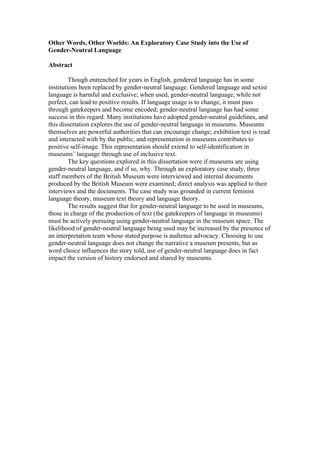Report
Share
Download to read offline

Recommended
Recommended
Using literature in EFL classesUsing literature-in-efl-classes-assessing-the-suitability-of-literary-texts-t...

Using literature-in-efl-classes-assessing-the-suitability-of-literary-texts-t...Meryandi Kriswindharta
کتیب الملخصات - المؤتمر الدولي السابع حول القضايا الراهنة للغات، علم اللغة، الترجمة و الأدب
12-11 يونيو 2022 ، الأهواز
لمزید من المعلومات، ﯾرﺟﯽ زﯾﺎرة ﻣوﻗﻌﻧﺎ اﻹﻟﮐﺗروﻧﻲ : WWW.LLLD.IR
لا تتردد فی مراسلتنا للاجابة عن ای استفسارات.
اللجنة المنظمة للمؤتمر،
الأهواز / الصندوق البريدی 61335-4619:
الهاتف :32931199-61 (98+)
الفاکس:32931198-61(98+)
النقال و رقم للتواصل عبر الواتس اب : 9165088772(98+)
WWW.LLLD.IR، البريد اﻹﻟﮑﺘﺮوﻧﻲ: info@pahi.ir
کتیب الملخصات - المؤتمر الدولي السابع حول القضايا الراهنة للغات، علم اللغة، ا...

کتیب الملخصات - المؤتمر الدولي السابع حول القضايا الراهنة للغات، علم اللغة، ا...The Annual International Conference on Languages, Linguistics, Translation and Literature
Book of Abstracts - The Seventh International Conference on Languages, Linguistics, Translation and Literature
11-12 June 2022 , Ahwaz
For more information, please visit the conference website:
WWW.LLLD.IR
Please feel free to write if there is any query.
The Conference Secretariat,
Ahwaz 61335-4619 Iran
(+98) 61-32931199
(+98) 61-32931198
(+98) 916-5088772 (WhatsApp Number)
WWW.LLLD.IR, Email: info@pahi.ir
Book of Abstracts - The Seventh International Conference on Languages, Lingui...

Book of Abstracts - The Seventh International Conference on Languages, Lingui...The Annual International Conference on Languages, Linguistics, Translation and Literature
More Related Content
Similar to Munholland Abstract
Using literature in EFL classesUsing literature-in-efl-classes-assessing-the-suitability-of-literary-texts-t...

Using literature-in-efl-classes-assessing-the-suitability-of-literary-texts-t...Meryandi Kriswindharta
کتیب الملخصات - المؤتمر الدولي السابع حول القضايا الراهنة للغات، علم اللغة، الترجمة و الأدب
12-11 يونيو 2022 ، الأهواز
لمزید من المعلومات، ﯾرﺟﯽ زﯾﺎرة ﻣوﻗﻌﻧﺎ اﻹﻟﮐﺗروﻧﻲ : WWW.LLLD.IR
لا تتردد فی مراسلتنا للاجابة عن ای استفسارات.
اللجنة المنظمة للمؤتمر،
الأهواز / الصندوق البريدی 61335-4619:
الهاتف :32931199-61 (98+)
الفاکس:32931198-61(98+)
النقال و رقم للتواصل عبر الواتس اب : 9165088772(98+)
WWW.LLLD.IR، البريد اﻹﻟﮑﺘﺮوﻧﻲ: info@pahi.ir
کتیب الملخصات - المؤتمر الدولي السابع حول القضايا الراهنة للغات، علم اللغة، ا...

کتیب الملخصات - المؤتمر الدولي السابع حول القضايا الراهنة للغات، علم اللغة، ا...The Annual International Conference on Languages, Linguistics, Translation and Literature
Book of Abstracts - The Seventh International Conference on Languages, Linguistics, Translation and Literature
11-12 June 2022 , Ahwaz
For more information, please visit the conference website:
WWW.LLLD.IR
Please feel free to write if there is any query.
The Conference Secretariat,
Ahwaz 61335-4619 Iran
(+98) 61-32931199
(+98) 61-32931198
(+98) 916-5088772 (WhatsApp Number)
WWW.LLLD.IR, Email: info@pahi.ir
Book of Abstracts - The Seventh International Conference on Languages, Lingui...

Book of Abstracts - The Seventh International Conference on Languages, Lingui...The Annual International Conference on Languages, Linguistics, Translation and Literature
Similar to Munholland Abstract (20)
Adjunctive english general extenders in newspaper editorials

Adjunctive english general extenders in newspaper editorials
Using literature-in-efl-classes-assessing-the-suitability-of-literary-texts-t...

Using literature-in-efl-classes-assessing-the-suitability-of-literary-texts-t...
کتیب الملخصات - المؤتمر الدولي السابع حول القضايا الراهنة للغات، علم اللغة، ا...

کتیب الملخصات - المؤتمر الدولي السابع حول القضايا الراهنة للغات، علم اللغة، ا...
Book of Abstracts - The Seventh International Conference on Languages, Lingui...

Book of Abstracts - The Seventh International Conference on Languages, Lingui...
EXPLORING THE TRANSLINGUAL APPROACH TO ENGLISH AS A FOREIGN LANGUAGE WRITING ...

EXPLORING THE TRANSLINGUAL APPROACH TO ENGLISH AS A FOREIGN LANGUAGE WRITING ...
149Harvard Educational Review Vol. 85 No. 2 Summer 2015

149Harvard Educational Review Vol. 85 No. 2 Summer 2015
149Harvard Educational Review Vol. 85 No. 2 Summer 2015

149Harvard Educational Review Vol. 85 No. 2 Summer 2015
Domestication of the English Language in Nigeria: An Examination of Morpho-Sy...

Domestication of the English Language in Nigeria: An Examination of Morpho-Sy...
Munholland Abstract
- 1. Other Words, Other Worlds: An Exploratory Case Study into the Use of Gender-Neutral Language Abstract Though entrenched for years in English, gendered language has in some institutions been replaced by gender-neutral language. Gendered language and sexist language is harmful and exclusive; when used, gender-neutral language, while not perfect, can lead to positive results. If language usage is to change, it must pass through gatekeepers and become encoded; gender-neutral language has had some success in this regard. Many institutions have adopted gender-neutral guidelines, and this dissertation explores the use of gender-neutral language in museums. Museums themselves are powerful authorities that can encourage change; exhibition text is read and interacted with by the public, and representation in museums contributes to positive self-image. This representation should extend to self-identification in museums’ language through use of inclusive text. The key questions explored in this dissertation were if museums are using gender-neutral language, and if so, why. Through an exploratory case study, three staff members of the British Museum were interviewed and internal documents produced by the British Museum were examined; direct analysis was applied to their interviews and the documents. The case study was grounded in current feminist language theory, museum text theory and language theory. The results suggest that for gender-neutral language to be used in museums, those in charge of the production of text (the gatekeepers of language in museums) must be actively pursuing using gender-neutral language in the museum space. The likelihood of gender-neutral language being used may be increased by the presence of an interpretation team whose stated purpose is audience advocacy. Choosing to use gender-neutral language does not change the narrative a museum presents, but as word choice influences the story told, use of gender-neutral language does in fact impact the version of history endorsed and shared by museums.